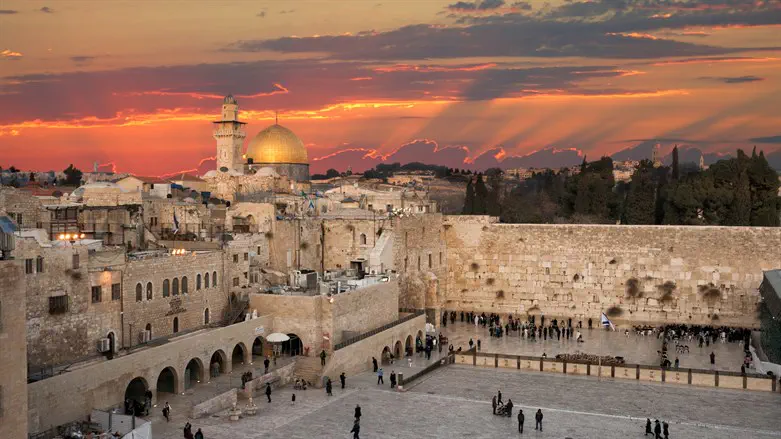
We read in our Parasha, of the wondrous Mitzvah that Moshe Rabbeinu commanded on his last day on earth:(31:10-12):
‘At the end of seven years, at the time of the Shmitta year, during the festival of Succot, when all Israel comes to appear before Hashem..in the place that He will choose, you shall read this Torah before all Israel, in their ears. הקהל: Gather together all the people..so that they will hear and so that they will learn, and they shall fear Hashem..and be careful to perform all the words of this Torah.’
The Sefer Hachinuch expounds that the שורש: the root of this Mitzvah, is that since all the essence of the nation of Israel is the Torah, and by it they are separated from all other peoples, it is apt that they should all assemble together, to hear its words. And when they wonder: What is this great gathering that they all assembled together? The answer will be: To hear the words of the Torah, which is our essence and our glory, and they will come, through that, to tell of its praises and majesty, and the desire for it, shall enter their hearts; and, because of this desire, they will learn to know Hashem, and merit His goodness’.
Rav Shimshon Raphael Hirsch comments:’The purpose of this Mitzvah is not to learn the Torah, as the Mitzvah to learn Torah binds each and every person in his daily way of life; rather, it is a Mitzvah which diverges from the regular regime, which recurs once every seven years, and has a different objective.
‘At the special time that calls for each person to unite with Hashen, the Shmitta year, before the people return to working the land, from which they had abstained during the Shmitta year, and during the festival of Succot, the festival which recalls to the people their long sojourn in the desert, when there was no agriculture and no commerce, only Hashem’s chesed and protection, as they are now about to re-start their life of agriculture and commerce.
‘This wondrous assembly will reinforce in their hearts that Hashem alone determines their fate and this will strengthen their awe of Hashen, and lead them to fulfill the supreme objective of all the Torah commandments:’To be careful to perform all the words of this Torah.’
Rav David Hofstedter adds:’The assembly of all the people to hear the words of the Torah from the King, comes to emphasize its supreme importance, and in its merit the people will come to fulfill the Mitzvah of learning Torah with greater enthusiasm and love- this is why the Mitzvah is called הקהל: gathering,as its main import is the gathering of all the people.
‘In this sense, it is a replication of the stand of Har Sinai, and this is alluded to by the language of the commandment closely resmbling that said at that stand.’
Rav Avigdor Nebenzahl sweetens this connection, commenting:’The Torah here is cognizant of the shortness of human memory, and therefore commanded this Mitzvah, so that every seven years we shpuld once again be witnesses to a kind of Matan Torah.’
The Abarbanel adds: ‘The Torah chose to command this reading only every seven years, and not each year, as, had the assembly taken place every year, even the impact of the King reading the Torah to all the people, would have been lessened- as the wise Shlomo Hamelch adjured:(Mishlei 25:17)’Visit your neighbour sparingly, lest he become sated with you, and hate you.
‘It therefore commanded that it occur once in seven years, and in the Shmitta year, when the people were not engaged in their own business affairs, and their food was miraculously provided by Hashem, they should perform this Mitzvah.’
Rav Yehonatan Eibeschitz contributes the following sage insight:’Why was the seventh year a year of Shmitta, of abstention from activity? Because in the preceding six years, the people were preoccupied with their work, and could not regularly devote time to Torah study; therefore the seventh year was declared a year of Shmitta, so they had time for regular Torah study in it.
‘However, this could lead them to think that they had learned enough Torah in the Shmitta year for their needs. Therefore, the Torah commanded them immediately after the Shmitta year: resume your Torah studies’.
Rav Zalman Sorotzkin adds a gem to explain why the Mitzvah of הקהל was to be performed only after the Shmitta year:’When Hashem wanted to instill His awe in the hearts of the people, especially those youngsters who had not seen His miracles with their own eyes, He chose the ‘appropriate time’ - just as, at Pesach, we are commanded to tell the story of the exodus from Egypt, when the matzah and maror are placed before us, to remind us of the miracles Hashem performed, to take us out of Egypt.
‘The end of the Shmitta year, when the people had left the land unworked for a whole year, and yet, as Hashem had promised, the crops that grew in the sixth year were miraculously sufficient for all their needs for the eight year, had the same impact.
‘With this before their eyes - the fulfillment of the miracle Hashem had promised- it was far ‘easier’ to ‘read this Torah in the ears of the people, so that they will hear and so that they will learn, and they shall fear Hashen..and be careful to perform all the words of this Torah’.